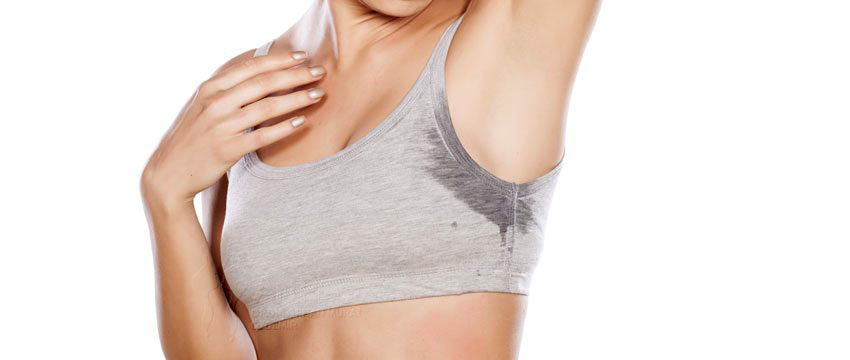Causes of Excessive Sweating
Excessive sweating is a condition known medically as hyperhidrosis. This is a common and socially uncomfortable condition in some people.
The problem of excessive sweating can be localized or generalized. When the body temperature rises, our brain sends a warning to the sweat glands to work to normalize the temperature. Thanks to the sweat glands that begin to secrete sweat, body temperature returns to normal and natural order is maintained.
Localized sweating is experienced mainly under the armpits, but also on the hands, feet, back, face and under the chest. If there is a sweating condition that causes stains and deformation on clothes and causes a bad odor in the body, it can be said that the person has excessive sweating problem. Sweating problems can occur for two reasons called essential and secondary.
Essential Sweating: It is a condition of excessive sweating triggered by emotional reasons such as stress, excitement, tension, embarrassment.
Secondary Sweating: Excessive sweating caused by health conditions such as thyroid, high blood pressure, neurological disorders, menopause.

Treatment Options
The problem of excessive sweating can be treated with surgical interventions and botox. Surgical treatments involving the complete removal of sweat glands by surgical methods are both laborious and scarring interventions. For this reason, the botox treatment method seems much more attractive to patients and is preferred because it is a very effective and trouble-free treatment method.
Treatment with Botox
Botox temporarily blocks the functioning of the nerves that reach and activate the sweat glands. During the treatment consisting of a single session, the application areas are cleaned with antiseptic solution and then numbed with the help of anesthetic cream. After numbing, Botox is injected into various points that are very close to each other in the treatment area with the help of very fine-tipped needles.
Sweating treatment with Botox is a painless treatment method. The treatment can be applied to the armpits, palms and soles of the feet. Botox is injected under or into the skin, not into the muscle.
The complaint of sweating stops completely 3-7 days after the procedure is performed, and the effect of the treatment continues for 9 months to 1 year.
Control is performed 15 days after the treatment. If there are areas where sweating persists (very rare), the injection is performed again after being subjected to the “Iodine-Starch” test.
Prescription Antiperspirants
In addition to antiperspirants that you can buy over the counter, there are also stronger prescription antiperspirants. These products often contain aluminum salts and can reduce sweating.
Iontophoresis
This is a treatment using electric current. A gentle electric current is passed through electrodes between two trays filled with water. The hands or feet are placed on this tray. This method temporarily shuts down the sweat glands.
Surgery
This surgical procedure, called sympathectomy, is used as a last resort to treat excessive sweating. The surgeon cuts the nerves that control sweating to reduce sweating.
Herbal Solutions
- Sage: Thanks to the tannins it contains, it can reduce sweating. You can drink sage by brewing it or apply it directly to the skin.
- Green Tea: With its antioxidant properties, it can prevent sweat glands from overworking.
- Aloe Vera: With its cooling properties, it can soothe the skin and control sweating.
- Chamomile: As a natural antiperspirant, it can reduce excessive skin hydration and sweating.
- Turmeric: Thanks to its anti-inflammatory properties, it can calm the skin and reduce perspiration.
Potential Complications
- Wrinkles: Some treatments, especially topical products applied on the skin, can affect the skin’s structure and elasticity, which can cause wrinkles over time.
- Skin Infections: Some products used to treat excessive sweating can weaken the skin’s natural barrier. This can allow pathogens such as bacteria and fungi to enter the skin and cause infections.
- Maceration: Maceration is a condition in which the skin turns white and soft due to constant moisturizing. Topical treatments against excessive sweating can cause the skin to become overly moisturized and thus cause maceration.
- Itchy Skin: Itching in the treated area is a common side effect, especially when antiperspirant products or medications are used. Itching can cause irritation of the skin in the treated area.
- Dry Skin: Some antiperspirant treatments can make the skin extremely dry. This can cause the skin to flake, crack and even injure.
- Sweat Pores: Treatments can cause sweat pores to become clogged. This can lead to the formation of pimples and blackheads and prevent the skin from breathing.
The Difference Between Night Sweats and Excessive Sweating
Excessive sweating and night sweats are two different conditions related to sweating and can occur for different reasons. The main differences between these two conditions:
Excessive Sweating (Hyperhidrosis)
- It is usually caused by genetic reasons.
- It can cause intense sweating in certain areas such as hands, feet, armpits and face.
- It usually starts at a young age and can last a lifetime.
- It can be triggered by external factors such as heat, excitement, stress or physical activity.
- It can be controlled with treatment methods such as topical antiperspirants, iontophoresis, botox injections and surgical procedures.
Night Sweating
- It is characterized by increased sweating, usually while sleeping in bed.
- It can cause even sweating throughout the body.
- It can occur due to certain health conditions (e.g. menopause, tuberculosis, HIV/Aids, some types of cancer) or medication side effects.
- Some infections, hormonal changes, hypoglycemia and some neurological conditions can also cause night sweats.
- It can be controlled by treating the root cause.
